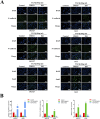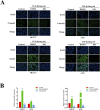Isoliensinine suppressed gastric cancer cell proliferation and migration by targeting TGFBR1 to regulate TGF-β-smad signaling pathways
- PMID: 39364054
- PMCID: PMC11446791
- DOI: 10.3389/fphar.2024.1438161
Isoliensinine suppressed gastric cancer cell proliferation and migration by targeting TGFBR1 to regulate TGF-β-smad signaling pathways
Abstract
Background: Gastric cancer (GC) ranks as the fifth most prevalent cancer globally, and its pronounced invasiveness and propensity to spread provide significant challenges for therapy. At present, there are no efficacious medications available for the treatment of patients with GC. Isoliensinine (ISO), a bisbenzylisoquinoline alkaloid, was isolated from Nelumbo nucifera Gaertn. It possesses anti-tumor, antioxidant, and other physiological effects. Nevertheless, there is currently no available study on the impact of ISO on GC, and further investigation is needed to understand its molecular mechanism.
Methods: ISO target points and GC-related genes were identified, and the cross-target points of ISO and GC were obtained. We then examined cross-targeting and found genes that were differentially expressed in GCs. Kaplan-Meier survival curves were used to screen target genes, and the STRING database and Cytoscape 3.9.1 were used to construct protein-protein interactions and drug-target networks. In addition, molecular docking studies confirmed the interactions between ISO screen targets. Finally, in vitro tests were used to establish the impact of ISO on GC cells.
Results: Through bioinformatics research, we have identified TGFBR1 as the target of ISO in GC. In addition, we noticed a substantial inhibition in GC cell proliferation, migration, and invasion activities following ISO treatment. Moreover, we noticed that ISO treatment effectively suppressed TGF-β-induced epithelial-mesenchymal transition (EMT) and activation of the TGF-β-Smad pathway. Furthermore, we discovered that siTGFBR1 nullified the impact of ISO on TGF-β-triggered migration, invasion, and activation of the TGF-β-Smad pathway.
Conclusion: Our research suggests that ISO specifically targets TGFBR1 and regulates the TGF-β-Smad signaling pathway to suppress the proliferation and migration of GC cells.
Keywords: epithelial-mesenchymal transition (EMT); gastric cancer; isoliensinine; metastasis; proliferation; transforming growth factor-β (TGF-β).
Copyright © 2024 Hu, Dai, Yuan, Li, Xu and Gao.
Conflict of interest statement
The authors declare that the research was conducted in the absence of any commercial or financial relationships that could be construed as a potential conflict of interest.
Figures









Similar articles
-
miR-96-5p regulated TGF-β/SMAD signaling pathway and suppressed endometrial cell viability and migration via targeting TGFBR1.Cell Cycle. 2020 Jul;19(14):1740-1753. doi: 10.1080/15384101.2020.1777804. Epub 2020 Jun 17. Cell Cycle. 2020. Retraction in: Cell Cycle. 2024 Jul-Aug;23(13-16):i. doi: 10.1080/15384101.2024.2370717. PMID: 32635855 Free PMC article. Retracted.
-
Fibroblastic galectin-1-fostered invasion and metastasis are mediated by TGF-β1-induced epithelial-mesenchymal transition in gastric cancer.Aging (Albany NY). 2021 Jul 14;13(14):18464-18481. doi: 10.18632/aging.203295. Epub 2021 Jul 14. Aging (Albany NY). 2021. PMID: 34260413 Free PMC article.
-
Babao Dan inhibits the migration and invasion of gastric cancer cells by suppressing epithelial-mesenchymal transition through the TGF-β/Smad pathway.J Int Med Res. 2020 Jun;48(6):300060520925598. doi: 10.1177/0300060520925598. J Int Med Res. 2020. PMID: 32529872 Free PMC article.
-
[Aberrant Activation Mechanism of TGF-β Signaling in Epithelial-mesenchymal Transition].Yakugaku Zasshi. 2021;141(11):1229-1234. doi: 10.1248/yakushi.21-00143. Yakugaku Zasshi. 2021. PMID: 34719542 Review. Japanese.
-
Transforming growth factor-beta signaling in epithelial-mesenchymal transition and progression of cancer.Proc Jpn Acad Ser B Phys Biol Sci. 2009;85(8):314-23. doi: 10.2183/pjab.85.314. Proc Jpn Acad Ser B Phys Biol Sci. 2009. PMID: 19838011 Free PMC article. Review.
Cited by
-
Isoliensinine exerts antitumor effects in lung adenocarcinoma by inhibiting APEX1-driven ROS production.Front Pharmacol. 2025 May 27;16:1555802. doi: 10.3389/fphar.2025.1555802. eCollection 2025. Front Pharmacol. 2025. PMID: 40495893 Free PMC article.
References
LinkOut - more resources
Full Text Sources
Miscellaneous

